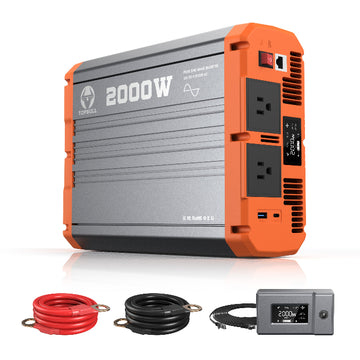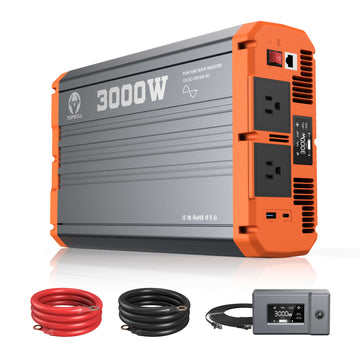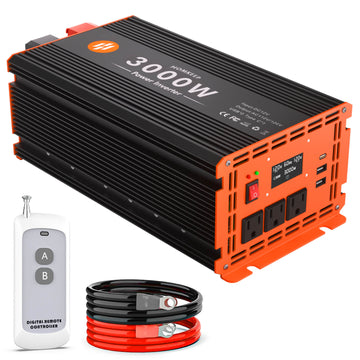In the driving trip for the laptop charging, camping with rice cooker cooking, and even long-distance driving for the car refrigerator power supply - car inverter so that the car instantly transformed into a “mobile power station”.
However, many car owners in the enjoyment of convenience at the same time, the heart always hangs a question: “does the inverter will drain the car battery? If so, what is the risk?”
The answer is: yes, but the degree of depletion depends on how it is used, and the risk is completely controllable.
- Risks in high-power scenarios: If an inverter of more than 1,000 W is used to drive a microwave oven, hairdryer or coffee maker, the battery can drop from full charge to a critical level where the vehicle cannot be started in less than 30 minutes (usually below 12 V). For example, an 800W rice cooker running for 1 hour may drain 40-50% of a typical car battery.
- Safety in low-power scenarios: If you only use a 50W inverter to charge a cell phone or tablet, or use a small 100W fan for a short period of time, the battery drain is almost negligible. For example, charging a cell phone for 1 hour only consumes 0.5%-1% of the battery power.
The key paradox is that the inverter itself does not “consume” the battery, but converts the power stored in the battery into AC power for the device. What really affects battery life is the power of the device, the duration of use and the health of the battery. If these factors are not taken into account, the inverter can turn from a “convenience tool” into a “battery killer”.
In the following, we will analyze the working principle, power consumption mechanism and battery protection strategy of inverters to provide you with a set of scientific usage guidelines, so that you can enjoy the freedom of electricity and avoid the risk of battery failure at the same time.
The Basic Principle of Car Power Inverter
The basic working principle of a car power inverter is to convert the DC power from the car battery into AC power that can be supplied to most appliances. Inverters usually come in different power levels, such as 400W, 1000W, 2000W or even higher. This means they can support different types of devices, but the higher the power, the greater the demand on the battery. It is important to note that inverters rely entirely on the car battery, not the engine, for their power.
The impact of inverters on batteries
Core factors in battery power consumption
Device power: High-power devices (e.g. hairdryers, microwave ovens) can quickly drain battery power. For example, a 500W rice cooker running for 1 hour may drain 20%-30% of an average car battery.
Usage time: The longer the continuous running time, the greater the battery depletion. If the inverter continues to work for hours, the battery may not be able to start the vehicle due to excessive discharge.
Battery condition: Older batteries or batteries with insufficient capacity (e.g. below 50% health) are more likely to be drained and even cause irreversible damage.
Inverter 0-load power consumption: Some inverters still consume a tiny amount of power (about 0.1-0.5A) when on standby, leaving them unplugged for a long period of time may drain the battery.
Potential Risks
Over-discharge: Car batteries are usually designed for short periods of high current discharge (e.g., starting the engine), and long periods of low current discharge caused by the inverter can accelerate battery aging.
Difficulty starting: If the battery charge falls below the starting threshold (usually at least 12V needs to be retained), the vehicle may not fire up.
How to minimize the risk of battery drain
- Choose the right inverter: Depending on the power of the devices you need to power, choose an inverter with the right power rating. If you only need to charge cell phones and laptops, a lower power inverter (e.g. 300W) is sufficient. While using an induction cooker requires more than 1000W.(Learn more: How to choose the right inverter for your car)
- Reasonable use time: Try to use the inverter while driving, so that the generator will provide electricity and reduce the burden on the battery. Avoid using the inverter for a long time in the parking state so that the battery power will not drop.
- Regularly check the battery health: Regularly check the status of the battery, including voltage and charging, to ensure that the battery is in good condition to support the normal operation of the inverter.
- Install an auxiliary battery: Isolate the main battery risk by powering the inverter with a dual battery system or portable power station. If you plan to use high-powered appliances frequently, consider using deep-cycle batteries (e.g. AGM, lithium batteries, etc.), which are designed for repeated discharging and are better suited for this purpose, and will also reduce damage to your car's battery from high-powered appliances. Suggestion for selection: 12V 100Ah deep cycle battery used with 2000W pure sine wave inverter can fully meet most of the power needs.
FAQs
Q1: Does the inverter consume power in standby?
A: Some inverters have standby power consumption, we suggest you choose a model with low standby power consumption (e.g. standby current <0.1A).
Q2: Will the inverter damage the car battery?
A: Long-term over-discharge will accelerate the aging of the battery, but reasonable use (e.g. controlling the time, choosing the right power) can avoid the damage.
Q3: How can I tell if the battery is drained by the inverter?
A: If the dashboard shows low voltage when you start the car, the engine turns over slowly, or you hear a “clicking” sound but can't ignite the car, the battery may be low.
Summary
Overall, car inverters are practical tools to enhance the convenience of using a car, but their power is completely dependent on the car battery, and irrational use may lead to battery depletion or even damage. By choosing the right inverter, using it while driving and keeping the battery in good condition, car owners can effectively reduce the risk of battery drain. While enjoying the convenience of using an inverter, we should also keep a high level of attention to battery maintenance and usage habits.













